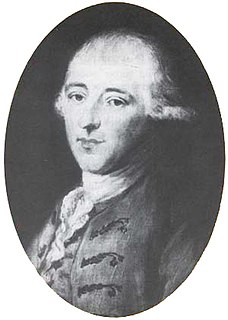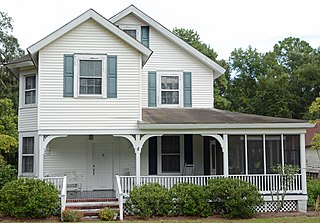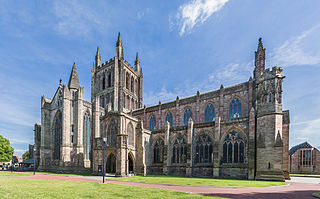
St. Simons Island is a barrier island and census-designated place (CDP) located on St. Simons Island in Glynn County, Georgia, United States. The names of the community and the island are interchangeable, known simply as "St. Simons Island" or "SSI", or locally as "The Island". St. Simons is part of the Brunswick, Georgia Metropolitan Statistical Area, and according to the 2010 census, the CDP had a population of 12,743.

The African Methodist Episcopal Church, usually called the A.M.E. Church or AME, is a predominantly African-American Methodist denomination. It is the first independent Protestant denomination to be founded by black people. It was founded by the Rt. Rev. Richard Allen in Philadelphia, Pennsylvania, in 1816 from several black Methodist congregations in the mid-Atlantic area that wanted independence from white Methodists. It was among the first denominations in the United States to be founded on racial rather than theological distinctions and has persistently advocated for the civil and human rights of African Americans through social improvement, religious autonomy, and political engagement. Allen, a deacon in Methodist Episcopal Church, was consecrated its first bishop in 1816 by a conference of five churches from Philadelphia to Baltimore. The denomination then expanded west and south, particularly after the Civil War. By 1906, the AME had a membership of about 500,000, more than the combined total of the Colored Methodist Episcopal Church in America and the African Methodist Episcopal Zion Church, making it the largest major African-American Methodist denomination. The AME currently has 20 districts, each with its own bishop: 13 are based in the United States, mostly in the South, while seven are based in Africa. The global membership of the AME is around 2.5 million and it remains one of the largest Methodist denominations in the world.

Pierce Butler was a South Carolina rice planter and politician, an officer in the Revolutionary War, and one of the Founding Fathers of the United States. He served as a state legislator, a member of the Congress of the Confederation, a delegate to the 1787 Constitutional Convention, and a member of the United States Senate.

The Mother Bethel African Methodist Episcopal Church is a historic church and congregation at 419 South 6th Street in Center City Philadelphia, Pennsylvania, USA. The congregation, founded in 1794, is the oldest African Methodist Episcopal congregation in the nation. Its present church, completed in 1890, is the oldest church property in the United States to be continuously owned by African Americans. It was designated a National Historic Landmark in 1972.
The term black church or African-American church refers to Protestant churches that currently or historically have ministered to predominantly black congregations in the United States. While some black churches belong to predominantly African-American denominations, such as the African Methodist Episcopal Church (AME), many black churches are members of predominantly white denominations, such as the United Church of Christ.

The Episcopal Diocese of Georgia, USA is one of 20 dioceses that comprise Province IV of the US Episcopal Church, and is a diocese within the worldwide Anglican Communion. The current bishop is Scott Anson Benhase who succeeded Henry I. Louttit, Jr. on January 23, 2010 when he was consecrated 10th Bishop of Georgia at a service held in the Savannah International Trade and Convention Center.

Michael Bruce Curry MStJ is an American bishop. He is the 27th and current presiding bishop and primate of The Episcopal Church. Elected in 2015, he is the first African American to serve as presiding bishop in The Episcopal Church. He was previously bishop of the Diocese of North Carolina.
Thomas Spalding was a United States Representative from Georgia. He was born in Frederica, Georgia, St. Simons Island, Glynn County, Georgia. He attended the common schools of Georgia and Florida and a private school in Massachusetts. He studied law and was admitted to the bar in 1795, but did not practice. He engaged extensively in agricultural pursuits.

First African Baptist Church, located in Savannah, Georgia claims to be derived from the first black Baptist congregation in North America. While it was not officially organized until 1788, it grew from members who founded a congregation in 1773. Its claim of "first" is contested by the Silver Bluff Baptist Church, Aiken County, South Carolina (1773), and the First Baptist Church of Petersburg, Virginia, whose congregation officially organized in 1774.

St. Peter's Church is a historic Episcopal church located on the corner of Third and Pine Streets in Philadelphia, Pennsylvania. It opened for worship on September 4, 1761 and served as a place of worship for many of the United States Founding Fathers during the period of the Continental Congresses. The building was designated a National Historic Landmark in 1996. The church remains an active parish; the current rector is the Rev. Claire Nevin-Field.

Chapel of the Cross is a parish of the Episcopal Church of the United States in Chapel Hill in the Diocese of North Carolina. It is the spiritual home to more than 1,600 communicants, including numerous students studying at the University of North Carolina at Chapel Hill.

Saint Paul's Church is a historic Episcopal church in downtown Augusta, Georgia, adjacent to Riverwalk Augusta. A member of the Episcopal Diocese of Georgia, Saint Paul's conducts its worship services using the 1979 Book of Common Prayer. The church, located on the corner of 6th and Reynolds Streets, is the oldest church congregation in Augusta. It was established in 1750 by the Church of England at the site of Fort Augusta. There have been five churches on the site. The current church building, which combines features of Federal architecture with those of the Georgian and Greek Revival styles, was designed by Henry Ten Eyck Wendell and dedicated in 1920. It can seat up to 600 people.

Robert Josias "Raphael" Morgan was a Jamaican-American who is believed to be the first Black Orthodox priest in the United States. After being active in other denominations, including the AME Church, Church of England, and the Episcopal Church, Morgan converted to Orthodoxy. He was ordained as an Orthodox priest of the Ecumenical Patriarchate. He was designated as the "Priest-Apostolic to America and the West Indies"(Greek: Ιεραποστολος). He claimed to have founded the "Order of Golgotha", but the Orthodox Church is not organized into orders.

McIntosh County Academy (MCA) is the only public high school in McIntosh County, Georgia, United States. It was formerly known as Darien High School.

Saint Agnes Episcopal Chapel is a Chapel of All Saints Episcopal Church. From 1888 until 2014 St. Agnes was its own Episcopal Parish but in November of that year it officially merged with St. Cyprian's Episcopal Church to form an entirely new parish: All Saints Episcopal Church. All Saints is one congregation making use of two buildings: St. Agnes Chapel and St. Cyprian's Chapel. They use their website and Facebook to publish their worship schedule and keep parishioners and visitors up to date on where worship will be each Sunday.

The Vernon Square–Columbus Square Historic District is a historic area on the eastern side of Darien, Georgia. It encompasses two squares of the original 1805 city plan, although Vernon Square now contains a circular street. The plan was derived from James Oglethorpe's plan for Savannah. The area of Vernon and Columbus Wards was platted in 1805. The historic buildings in the area date back to the mid-19th and early 20th centuries. The houses are mostly modest wood-framed structures with weatherboard siding and wood detail.

Grace Episcopal Church is an active and historic Episcopal church in Madison, New Jersey, United States. Established in 1854, Grace has the largest membership of any parish in the Episcopal Diocese of Newark, with traditional "high church" Christian worship and a strong choral music program.

Anna Ellison Butler Alexander was the first and only African-American consecrated a Deaconess in the Episcopal Church. She served in the Episcopal Diocese of Georgia during her entire career, and may be remembered in the Calendar of saints on September 24.























